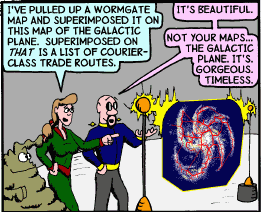Wormgates
Description[edit]
A wormgate requires a superjovian mass, and rips a hole in space big enough for starships to pass through in one piece. It's fast, but you can't carry it with you, and you can only go some place where there's a wormgate at the other end. You end up wasting a lot of time and energy traveling from the wormgate to your actual destination 2001-03-24. The wormgate network connects over a hundred thousand star systems in the Milky-Way Galaxy and for at least that many years it has been the only way to get around. For a new civilization to join the wormgate network they would have to wait until a pre-tuned wormgate arrived in their star system. This was the status quo until Kevyn Andreyasn invented the Teraport-System. Until that time it was considered common knowledge that there was no way into or out of hyperspace without using a wormgate.
Wormgates come in three flavors: hub gates at galactic crossroads, serial gates for long routes, and terminal gates for individual systems. Loss of a wormgate would mean stagnation and economic collapse, lasting likely for centuries until a replacement gate could be positioned or rebuilt. Because of this, wormgates are stridently protected, and a great liability to a system. Detuning a gate effectively disconnects the wormgate and system from the rest of the galaxy.
History[edit]
Wormgates are as timeless as the galactic civilizations, dating back at least 100,000 years, if not more. By the time of Kevyn's invention of the Teraport, there were over 100,000 settled star systems in the Wormgate registry 2003-05-23.
Notable Examples[edit]
- Nejjat wormgate
Appearances[edit]
First appearance[edit]
A Warrant-class Partnership Collective ship travels through a wormgate to the Kelrik Hub 2000-10-01.
Other notable appearances[edit]
Detuning a wormgate: 2001-05-16
Author's Note[edit]
[This space is reserved exclusively for Howard!]
Speculation[edit]
[Insert uncertain and speculative facts about the technology. Include links to Schlock in the Real World where appropriate.]
